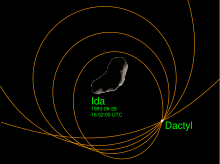|
Dactyl (moon)
Dactyl (/ˈdæktɪl/ DAK-til; formally (243) Ida I Dactyl) is a small asteroid moon 1,200 by 1,400 by 1,600 m (3,900 by 4,600 by 5,200 ft), in size) that orbits 243 Ida, a main-belt asteroid. It was imaged by the Galileo spacecraft on August 28, 1993; Dactyl was discovered while examining the delayed image downloads from Galileo on February 17, 1994. It was provisionally designated S/1993 (243) 1.[1] The satellite was named after the mythical creatures called dactyls, who, according to Greek mythology, lived on Mount Ida.[2] Orbit Dactyl's orbit around Ida is not precisely known. Galileo was in the plane of Dactyl's orbit when most of the images were taken, which made determining its exact orbit difficult.[3] Dactyl orbits in the prograde direction[4] and is inclined about 8° to Ida's equator.[5] Based on computer simulations, Dactyl's pericenter must be more than about 65 km (40 mi) from Ida for it to remain in a stable orbit.[6] The range of orbits generated by the simulations was narrowed down by the necessity of having the orbits pass through points at which Galileo observed Dactyl to be at 16:52:05 UT on 28 August 1993, about 90 km (56 mi) from Ida at longitude 85°.[7][8] On 26 April 1994, the Hubble Space Telescope observed Ida for eight hours and was unable to spot Dactyl. It would have been able to observe it if it were more than about 700 km (430 mi) from Ida.[3] If in a circular orbit at the distance at which it was seen, Dactyl's orbital period would be about 20 hours.[9] Its orbital speed is roughly 10 m/s (33 ft/s), "about the speed of a fast run or a slowly thrown baseball".[3] OriginThe origins of Dactyl are unclear, but two main hypotheses exist. The first is that Dactyl and Ida formed at the same time, and the second is that Dactyl was knocked loose by a later impact.[10][11] Dactyl was the first asteroid moon discovered. Its discovery settled the long debate over the existence of asteroid moons. See alsoReferences
Works cited
External links
|
||||||||||||||


